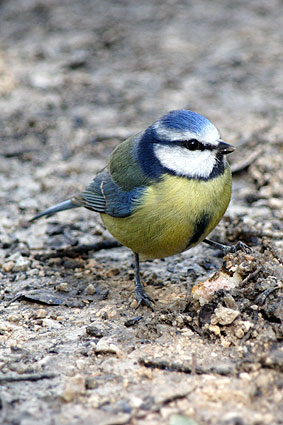Blue Tits are common throughout the Iberian Peninsula with some 1-3 millions pairs, except for arid, treeless areas such as parts of Murcia and Southern Valencia, and the Ebro Depression, where they are rarer.
Blue tits in the Canaries are now considered are seperate species Cyanistes teneriffae (African Blue Tit). A number of sub-species of blue tits are counted for the Archipeligo, depending whether you're a splitter or a lumper. We might call a splitter a nit-picker. We might say a lumper denies the existence of sub species. Juan Carlos Ferndadez of Exotic Birds in Spain sent me this revised list of Canarian/Iberian blue tits. He is unquestionably a splitter.
-Cyanistes teneriffae degener (Lanzarote and Fuerteventura).
-Cyanistes teneriffae teneriffae (Gran Canaria, Tenerife and La Gomera).
-Cyanistes teneriffae ombriosus (El Hierro).
-Cyanistes teneriffae palmensis (La Palma).
-Cyanistes teneriffae ultramarinus (northwestern Africa).
-Cyanistes teneriffae cyrenaicae (Libia).
In contrast, blue tits in the Iberian Peninsula belong to the species -Cyanistes caeruleus (Blue Tit), with the following sub species:
-Cyanistes caeruleus caeruleus (Continental Europe from northern
Spain,> France, and Norway east to northern Greece, northwestern Asia Minor,
Crimea, Volga River, and central Urals).
-Cyanistes caeruleus ogliastrae (Portugal, southern Spain, Corsica
and Sardinia).
-Cyanistes caeruleus balearicus (Mallorca, vagrant to Eivissa).
The old Parus genus has been changed to Cyanistes and the old Canarian and North African subspecies have been lumped together to form Cyanistes teneriffae. Although this new classification has not yet been accepted throughout Europe the British Ornithologists' Union now accepts this change.
Spanish blue tits are generally sendentary. Studies suggest they are taken by a range of predators in Spain in low numbers, incluiding
montagu's harrier, tawny owl and sparrowhawk, the latter in high proportion in Tenerife.
In Spanish a blue tit is a Herrerillo Común, which might translate as a "little smith" or a "smithy", a good name for this industrious little bird. In Catalan its a Mallerenga Blava. A blue quarryman, perhaps, with some imagination.
|

Photo of Blue Tit kindly sent to me by Clive of Natural Images. Clive runs guided walking tours in the Sierra de Grazalema
|
